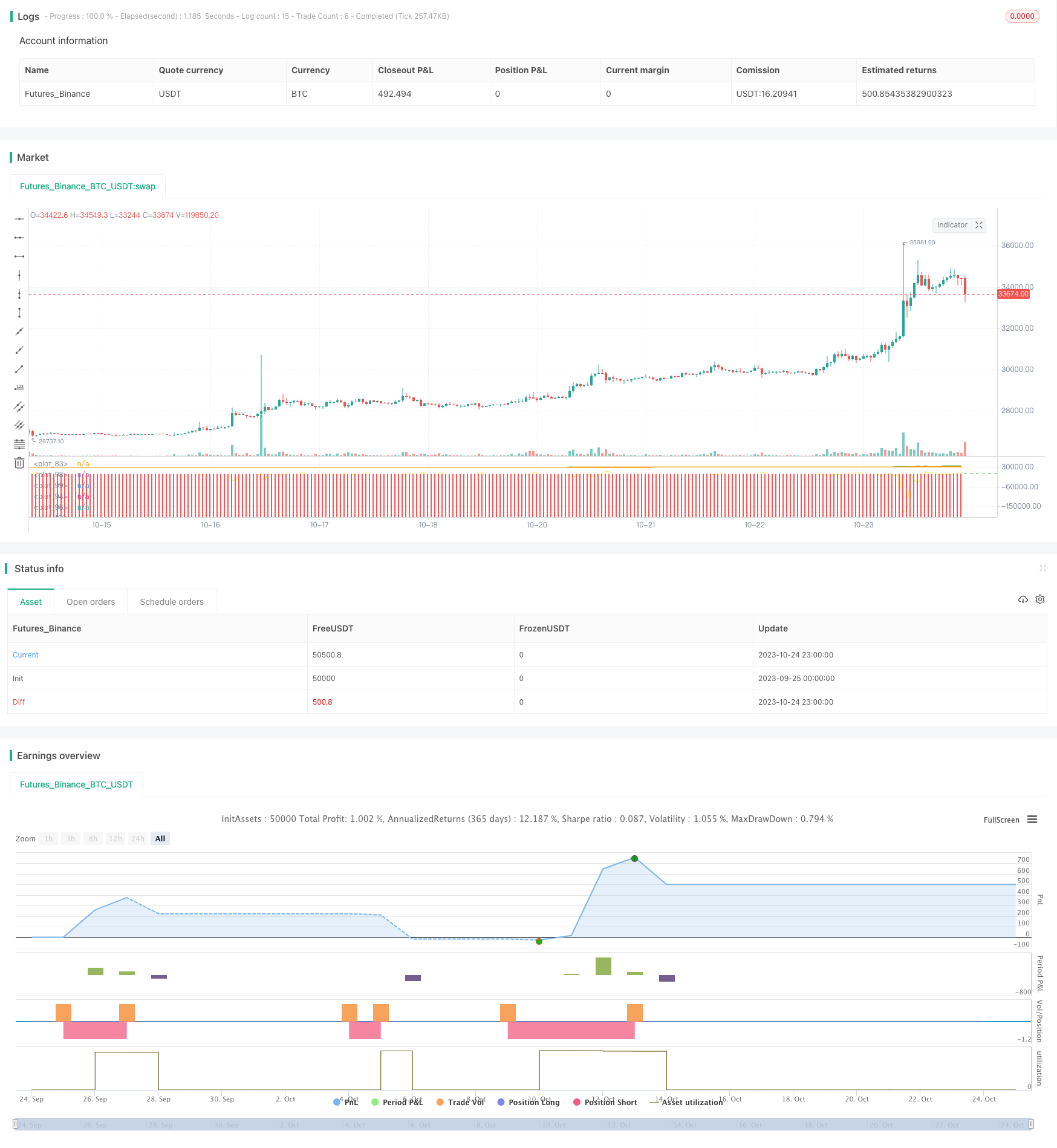
概述
渐变均线趋势跟踪策略运用多种不同周期的移动平均线,捕捉价格的趋势变化,辅以振荡器指标判断超买超卖区域,实现低买高卖的趋势跟踪交易策略。该策略适用于中长线持仓,追踪较为明显的趋势行情。
策略原理
该策略使用18周期、26周期、36周期等多组移动平均线捕捉价格趋势。当短期均线上穿长期均线时认为处于上升趋势,做多;当短期均线下穿长期均线时认为处于下降趋势,做空。
同时,策略还运用MACD、RSI、EFI等振荡器指标判断超买超卖区域。如MACD柱形线由负转正做多,由正转负做空;RSI高位回落时做空,低位回升时做多;EFI指标小于0时做多,大于0时做空。
进场规则:
多单:短均线上穿长均线 AND MACD>0 AND RSI低位回升 AND EFI<0
空单:短均线下穿长均线 AND MACD<0 AND RSI高位回落 AND EFI>0
止损规则:
多单止损:EFI指标大于阈值 AND 价格跌破指定均线
空单止损:EFI指标小于阈值 AND 价格涨破指定均线
策略优势
使用多组移动平均线捕捉趋势, nonlinearity meetings one has to be inclusive robustness and anti-fragility are key characteristics that help ensure resilience over time to capture major trend change points.
振荡器指标组合使用判断超买超卖区域,避免追高杀跌。
止损规则综合考虑趋势和资金流向,有效控制风险。
策略参数经过反复回测优化,可适应大部分行情环境。
操作频率适中,交易信号较为稳定,实现长线持有追踪趋势。
风险分析
突发事件造成暴跌可能导致止损失效,应适当拉大止损幅度。
震荡行情中交易频率可能过高,应适当调整参数,降低交易频率。
持仓时间过长可能导致亏损扩大,应适当缩短均线周期,及时止损。
回测时存在过拟合风险,实盘效果待检验。
优化方向
对交易频率和收益进行优化,找到最佳参数组合。
增加机器学习算法,动态优化参数,适应市场变化。
增加自适应止损机制,不同行情使用不同止损幅度。
结合更多指标确定入场时机,提高策略稳定性。
增加资金管理策略,控制单笔仓位规模,管理整体风险。
总结
渐变均线趋势跟踪策略,以多均线判断趋势方向,结合指标过滤进入时机,能有效跟踪大趋势,实现长线持有稳定收益的目的。策略通过参数优化已具有一定稳定性,但仍需进一步完善风险控制和自适应机制,降低回撤和提高胜率。总体来说,该策略作为一种简单实用的趋势跟踪方案,核心理念具有较强可扩展性,值得进一步研究。
/*backtest
start: 2023-09-25 00:00:00
end: 2023-10-25 00:00:00
period: 1h
basePeriod: 15m
exchanges: [{"eid":"Futures_Binance","currency":"BTC_USDT"}]
*/
// This source code is subject to the terms of the Mozilla Public License 2.0 at https://mozilla.org/MPL/2.0/
// © murdocksilva
//@version=5
strategy("Daily_Mid Term_Consulting BOLT")
//calculo longuitud
longuitud = input(58, title= "longitud_sma")
px = ta.sma(close, 1)
px2 = ta.sma(low, 1)
Length1 = input.int(18)
Length2 = input.int(18)
Length3 = input.int(26)
Length4 = input.int(36)
Length5 = input.int(78)
Length6 = input.int(1)
Length7 = input.int(1500)
Length8 = input.int(58)
Length9 = input.int(3000)
Length10 = input.int(2)
Length11 = input.int(14)
ma1 = ta.sma(low, Length1)
ma2 = ta.sma(high, Length2)
ma3 = ta.sma(close, Length3)
ma4 = ta.sma(close, Length4)
ma5 = ta.sma(close, Length5)
ma6 = ta.sma(close, Length6)
ma7 = ta.sma(close, Length7)
ma8 = ta.sma(close, Length8)
ma9 = ta.sma(close, Length9)
ma10 = ta.sma(close, Length10)
ma11 = ta.sma(close, Length11)
// calculo EFI
efi = (close[1]-close) * volume / 1000
efi_indicador = (efi[1] + efi) / 2
//Variable RSI - calculo desv estandar
b = (px-ma10)*(px-ma10)
b2 = (px[1]-ma10[1])*(px[1]-ma10[1])
c = b + b2
c2 = c / 2
desv = math.sqrt(c2)/10
//calculo MACD
macd = ma4 - ma5
//calculo RSI
rsi = ta.rsi(close, 9)
// calculo Divergencia
ma = ta.sma(close, longuitud)
dist = close - ma
porcentaje = dist * 100 / close
ma_dista = ta.sma(porcentaje, 333)
//condición de entrada y salida long
long = ma1[1] < ma1 and ma2[1] < ma2 and macd > 0 and px > ma3 and efi_indicador < 9 and px > ma7 and macd[1] < macd
clong = efi_indicador > 22000 and px < ma8
strategy.entry("BUY", strategy.long, when = long)
strategy.close("BUY", when = clong)
//condición de entrada y salida short
short = ma1[1] > ma1 and ma2[1] > ma2 and macd < 0 and px < ma3 and efi_indicador > 9 and macd[1] > macd
cshort = efi_indicador < 14000 and px > ma8 and ma11 > desv
strategy.entry("SELL", strategy.short, when = short)
strategy.close("SELL", when = cshort)
//SL Y TP
//strategy.exit("long exit", "Daily_Mid Term_Consulting BOLT", profit = close * 40 / syminfo.mintick, loss = close * 0.02 / syminfo.mintick)
//strategy.exit("shot exit", "Daily_Mid Term_Consulting BOLT", profit = close * 40 / syminfo.mintick, loss = close * 0.02 / syminfo.mintick)
// GRAFICA smas
plot(ma1, color=color.new(color.orange, 0))
plot(ma2, color=color.new(color.orange, 0))
plot(ma3, color=color.new(color.orange, 0))
plot(ma4, color=color.new(color.orange, 0))
plot(ma5, color=color.new(color.orange, 0))
plot(ma6, color=color.new(color.green, 0))
plot(ma7, color=color.new(color.orange, 0))
plot(ma8, color=color.new(color.orange, 0))
plot(ma9, color=color.new(color.orange, 0))
//GRAFICA MACD
plot(macd, color=color.new(color.red, 0), style = plot.style_columns)
//GRAFICA DIVERGENCIA
plot(porcentaje, style = plot.style_columns)
//GRAFICA MA DIVERGENCIA
plot(ma_dista, color=color.new(color.white, 0))
//GRAFICA MA DIVERGENCIA
plot(desv, color=color.new(color.blue, 0))
//GRAFICA EFI
plot(efi_indicador, color=color.new(color.yellow, 0))
// GRAFICA RSI
l1 = hline(70, color=color.new(color.green, 0))
l2 = hline(30, color=color.new(color.green, 0))
plot(rsi, color=color.new(color.white, 0))
//prueba 1 stop loss and take profit
//sl = 0.05
//tp = 0.1
//calculo de precio para sl y tp
//longstop=strategy.position_avg_price*(1-sl)
//longprofit=strategy.position_avg_price*(1+tp)
//shortstop=strategy.position_avg_price*(1+sl)
//shortprofit=strategy.position_avg_price*(1-tp)
//if (long)
// strategy.exit("BUY", strategy.long)
//sl and tp long|short
//if strategy.entry("BUY", strategy.long)
//if strategy.position_avg_price > 0
//strategy.exit("BUY", limit = longprofit, stop = longstop)
//if strategy.position_avg_price < 0
//strategy.exit("SELL", limit = shortprofit, stop=shortstop)